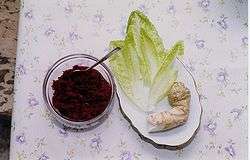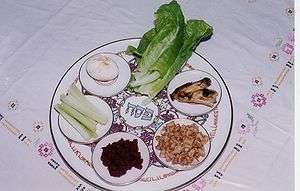Maror


Maror (Hebrew: מָרוֹר mārôr) or Marror refers to the bitter herbs eaten at the Passover Seder in keeping with the biblical commandment "with bitter herbs they shall eat it." (Exodus 12:8).
Biblical source
In some listings of the 613 commandments, such as the Minchat Chinuch, the biblical obligation to consume maror is included within the commandment to consume the meat of the sacrificial Paschal offering.[1] Ever since the Paschal offering ceased to exist with the destruction of the Temple in Jerusalem in 70 CE, the obligation to consume maror on the first night of Passover has been rabbinical in nature. The only two biblical reference to the maror is the verse quoted above (Exodus 12:8) in which it is mentioned in reference to the offering, and in Numbers 9:11 where "They are to eat the lamb, together with the unleavened bread and bitter herbs".[1] This is in contradistinction to the obligation to consume matzo on the first night of Passover, which remains a biblical commandment even in the absence of the Paschal Lamb, because there are other biblical verses that mention matzo as a standalone obligation (Exodus 12:18, Deuteronomy 16:8)
The word derives from the Hebrew word mar (מֵר or מָרָה — "bitter"), and thus may be related to the English word myrrh (through Aramaic ܡܪܝܪܐ mriro, in Arabic مرّ murr).
Symbolism
According to the Haggadah, the traditional text which is recited at the Seder and which defines the Seder's form and customs, the maror symbolizes the bitterness of slavery in Egypt. The following verse from the Torah underscores that symbolism: "And they embittered (ve-yimareru וימררו) their lives with hard labor, with mortar and with bricks and with all manner of labor in the field; any labor that they made them do was with hard labor" (Exodus 1:14).
Use at the Seder
Maror is one of the foods placed on the Passover Seder Plate and there is a rabbinical requirement to eat maror at the Seder. Chazeret (Hebrew: חזרת) is used for the requirement called korech, in which the maror is eaten together with matzo. There are various customs about the kinds of maror placed at each location.
During the Seder, each participant recites a specific blessing over the maror and eats it. It is first dipped into the charoset—a brown, pebbly mixture which symbolizes the mortar with which the Israelites bound bricks for the Egyptians. The excess charoset is then shaken off and the maror is eaten. The halakha (Jewish Law) prescribes the minimum amount of maror that should be eaten to fulfill the mitzvah (a kazayis or kezayit, literally meaning the volume of an olive) and the amount of time in which it should be consumed. To fulfill the obligation, the flavor of the maror must be unadulterated by cooking or preservatives, such as being soaked in vinegar.[2]
Types of maror
The Mishnah[3] specifies five types of bitter herbs eaten on the night of Passover: ḥazeret (lettuce),[4] ʿuleshīn (endive/chicory),[5] temakha,[6] ḥarḥabina (sweet clover or Eryngium creticum),[7] and maror (likely Sonchus oleraceus, a type of dandelion).[8]
The most common vegetables used as bitter herbs are horseradish and romaine lettuce.
Some Sephardic families use green onions, while "karpas" is thought to be either curly parsley or celery, eaten for the requirement of "maror."
Lettuce
Wild or prickly lettuce (Lactuca serriola), found in Israel, is a bitter vegetable that fits all descriptions of Chazeret in the Talmud.
Romaine lettuce is not initially bitter, but becomes so later on, which is symbolic of the experience of the Jews in Egypt.[9] The "later" bitterness of lettuce may refer to a bitter aftertaste.[10] Alternatively, it may refer to fact that lettuce plants become bitter after they "bolt" (flower), a process which occurs naturally when days lengthen or temperatures rise.[11]
Horseradish
Rabbi Yom-Tov Lipmann Heller, in his Tosafot Yom-Tov, believes the Mishna's "temakha" to be "cren" (horseradish), an opinion disputed by other rabbinic scholars.
Although many Jews use Khreyn condiment (a mixture of cooked horseradish, beetroot and sugar), the Shulchan Aruch requires that maror be used as is, that is raw, and not cooked or mixed with salt, vinegar, sugar, lemon, or beets.[12]
References
| Wikimedia Commons has media related to Maror. |
- 1 2 Minchat Chinuch 6:14 u'v'mitzvah
- ↑ Mishna Pesachim 2:6
- ↑ Pesahim 2:6
- ↑ Thus explained in Rabbi Hai Gaon's Commentary on Mishnah Uktzin 1:2 [3]; Sefer Arukh, s.v. חזרת; Mishnah Commentary of Rabbi Nathan, President of the Academy, s.v. Mishnah Kila'im 1:2; Zohar Amar, Flora and Fauna in Maimonides' Teachings, Kefar Darom 2015, p. 77 OCLC 783455868[Hebrew].
- ↑ Yehuda Felix, Mareos Hamishna. Source
- ↑ The Jerusalem Talmud (Pesahim 2:5 [18a]) calls the תמכה by the name גנגידין (Gingidium), which, according to Dioscorides (Book II-167), is a kind of chervil, and can apply to any of the following genera: Chaerophyllum, Anthriscus, Chaetosciadium and Scandix. Of these, the most commonly grown chervil in Israel is Chaetosciadium trichospermum. Cf. William Smith (ed.), Dictionary of Greek and Roman Antiquities, Third edition, New York 1858, s.v. γιγγίδιον ("gingidium"), "a kind of chervil."
- ↑ El'ad Kapah, The Identification of the Mishna Plants According to Rabbi Nathan's Commentary of the Mishna, Ramat-Gan 2007, p. 48 (Hebrew); Zohar Amar, Flora and Fauna in Maimonides' Teachings, Kfar Darom 2015, pp. 88–89 OCLC 783455868. The species is variously identified as a vine growing around palms, a type of thistle, or a type of acacia.
- ↑ Adin Steinsaltz, Talmud Bavli - explained, punctuated and translated", Pesachim, volume A, p.276
- ↑ Talmud, Pesachim 39a
- ↑ Pesachim 39a, Koren commentary
- ↑ Why Lettuce Bolts and How to Stop It
- ↑ Orach Chaim 473:5